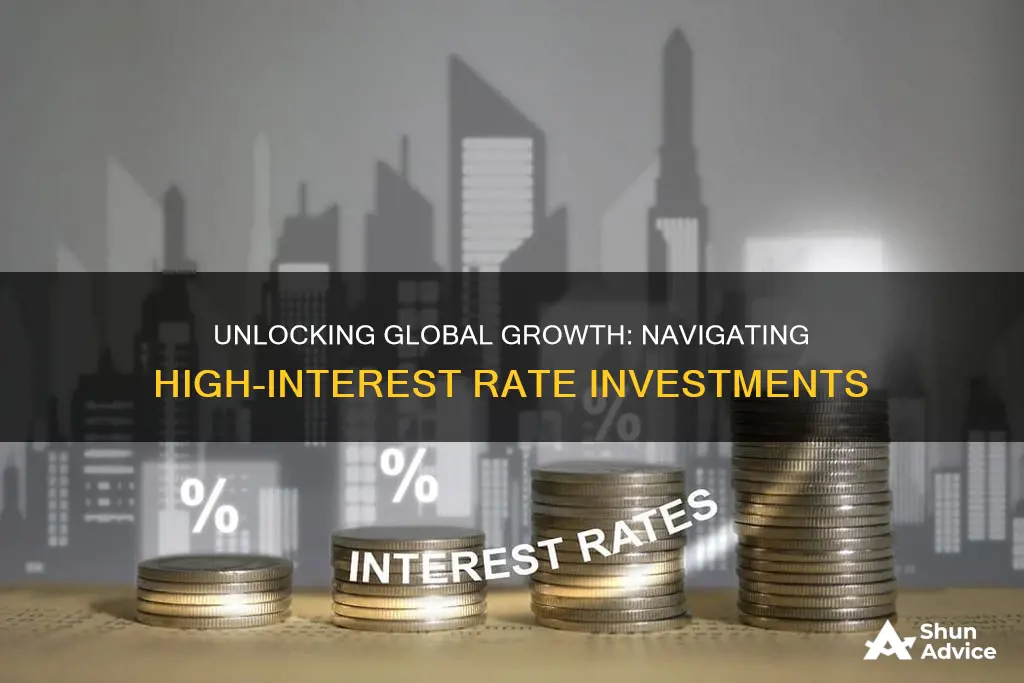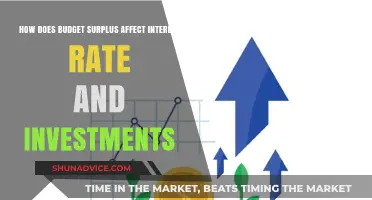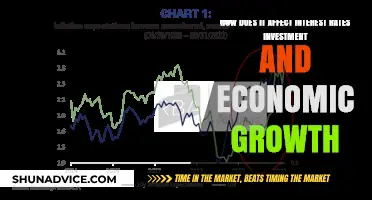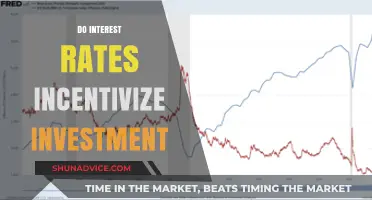
When considering investment opportunities, the interest rates of a country can be a significant factor to evaluate. High interest rates can present both advantages and challenges for investors. On one hand, they may attract foreign capital and stimulate economic growth, making the country an attractive investment destination. However, high interest rates can also lead to inflationary pressures and potentially reduce the purchasing power of the currency. This article will explore the pros and cons of investing in countries with high interest rates, examining the potential risks and benefits to help investors make informed decisions.
What You'll Learn
- Risk and Reward: High interest rates can attract investors, but carry risks like economic instability
- Inflation Impact: Interest rates affect inflation, which can influence investment returns and market sentiment
- Monetary Policy: Central banks' decisions on interest rates shape economic conditions and investment strategies
- Currency Fluctuations: Interest rates influence currency values, impacting the profitability of international investments
- Global Economic Trends: Interest rate changes reflect broader economic trends, affecting investment decisions and market dynamics

Risk and Reward: High interest rates can attract investors, but carry risks like economic instability
High interest rates can be a double-edged sword for investors, offering both opportunities and potential pitfalls. On one hand, they can attract investors seeking attractive returns, especially in a low-interest-rate environment. When a country's central bank raises interest rates, it often indicates a strong economy and a stable financial system, which can make it an appealing destination for investors. Higher interest rates mean that savings accounts, bonds, and other fixed-income investments will yield more significant returns, enticing those looking to grow their wealth. This can lead to increased capital inflows, boosting the country's currency and potentially making it a prime location for international investors.
However, this scenario also presents several risks that investors should carefully consider. Firstly, high interest rates can sometimes be a sign of economic instability. Central banks may raise rates to combat inflation or cool down an overheating economy. While this can lead to a more balanced economic state, it might also indicate underlying issues. For instance, if a country is experiencing high inflation, raising interest rates could be a desperate measure to control spending and borrowing, which might not be sustainable in the long term. This could potentially lead to a recession or economic downturn if not managed properly.
Another risk is the potential for capital flight. When interest rates are high, investors might be tempted to move their funds to countries with even higher returns. This can result in a rapid outflow of capital from the country with the higher interest rate, causing its currency to weaken and potentially leading to a financial crisis. Moreover, high interest rates can make a country's exports less competitive in the global market. With a stronger domestic currency, the cost of imports becomes cheaper, putting local industries at a disadvantage and potentially leading to trade deficits.
Despite these risks, investing in countries with high interest rates can still be a strategic move. It often indicates a country's commitment to financial stability and can provide a safety net during economic downturns. Investors should conduct thorough research, considering factors like the country's economic policies, inflation rates, and the overall health of its financial markets. Diversification is key; investors might want to consider a mix of high-interest-rate countries and those with more stable but lower rates to balance risk and reward.
Maximize Your Returns: Strategies for 10% Investment Interest
You may want to see also

Inflation Impact: Interest rates affect inflation, which can influence investment returns and market sentiment
Interest rates play a pivotal role in the economy, and their impact on inflation is a critical consideration for investors. When interest rates are high, they often have a direct effect on inflation, which can significantly influence investment strategies and market dynamics. Here's an exploration of this relationship and its implications:
Understanding the Inflation-Interest Rate Link:
High interest rates can act as a powerful tool to combat inflation. Central banks often raise interest rates to cool down an overheating economy and control rising prices. When interest rates increase, borrowing becomes more expensive, which can reduce consumer spending and business investments. This decrease in demand helps to stabilize prices, as the supply of goods and services remains relatively constant. As a result, inflation tends to decrease, making it a crucial factor for investors to consider.
Impact on Investment Returns:
Inflation and interest rates have a symbiotic relationship. When interest rates rise, it can lead to higher returns on fixed-income investments like bonds. This is because bond prices and interest rates move in opposite directions; when rates go up, bond prices typically fall, and vice versa. Therefore, investors seeking stable returns in a high-interest-rate environment might find fixed-income securities attractive. However, it's essential to note that this dynamic can also make equity investments less appealing, as higher interest rates may reduce the profitability of businesses, especially those heavily reliant on borrowing.
Market Sentiment and Investor Behavior:
The relationship between interest rates and inflation significantly influences market sentiment. During periods of high interest rates, investors might become more cautious, as the cost of borrowing increases. This can lead to a shift in investment strategies, with a potential move towards more conservative options. Additionally, high interest rates may prompt investors to reconsider their exposure to emerging markets, as local currencies can weaken due to capital outflows. Market sentiment can also impact stock prices, with some sectors potentially suffering from reduced investor confidence.
Diversification and Risk Management:
Investing in countries with high interest rates can be a strategic move, but it should be approached with caution and a well-diversified portfolio. Here's why: Firstly, high interest rates can attract foreign investment, potentially strengthening the local currency, which may impact the profitability of multinational corporations. Secondly, a country's inflation rate can vary across sectors, so investors should research specific industries to identify those that might benefit from or be protected against inflation. Diversification across asset classes, sectors, and regions is key to managing risk in such an environment.
In summary, the relationship between interest rates and inflation is a critical aspect of investment decision-making, especially when considering countries with high interest rates. Investors should stay informed about economic indicators and market trends to make well-informed choices, ensuring their portfolios are aligned with their financial goals and risk tolerance.
Unleash Compound Interest: Strategies to Find Your Initial Investment
You may want to see also

Monetary Policy: Central banks' decisions on interest rates shape economic conditions and investment strategies
The decisions made by central banks regarding interest rates have a profound impact on the economic landscape and investment opportunities, especially when considering countries with high interest rates. These monetary policies are a powerful tool to influence economic conditions and can significantly affect investment strategies. When a central bank raises interest rates, it typically aims to control inflation and stabilize the economy. Higher interest rates make borrowing more expensive, which can lead to reduced consumer spending and business investment. This, in turn, may slow down economic growth, as the demand for goods and services decreases. As a result, businesses might cut back on production, potentially leading to job losses and a reduction in overall economic activity. This scenario is particularly relevant for countries with high interest rates, as it can create a challenging environment for investors.
In such economies, the cost of borrowing is already relatively high, and raising interest rates further can make it even more expensive for businesses and individuals to access credit. This may discourage investment, as potential investors might be hesitant to commit capital in an environment where borrowing costs are already elevated. However, high interest rates can also present opportunities for investors. When interest rates are high, it often indicates that the central bank is taking measures to combat inflation. This can be attractive to investors seeking stable returns, as high interest rates suggest a controlled and potentially predictable economic environment.
For those looking to invest, the key is to understand the underlying reasons for high interest rates and assess their potential impact on the specific country or sector in question. Investors might consider the following strategies:
- Diversification: Diversifying investments across different countries and sectors can help mitigate the risks associated with high interest rates. By spreading investments, investors can reduce the potential negative impact of a single country's economic policies.
- Long-Term Perspective: High interest rates may create short-term challenges, but they can also indicate a central bank's commitment to economic stability. Investors with a long-term outlook might view these conditions as an opportunity to secure attractive returns over time.
- Sector-Specific Analysis: Examining the impact of interest rates on specific sectors is crucial. Some sectors, like banking and financial services, might benefit from higher interest rates, as they can increase lending profits. Others, such as consumer-facing industries, may struggle due to reduced consumer spending.
- Local Market Analysis: Understanding the local market dynamics and the specific reasons for high interest rates in a country is essential. Local factors, such as inflationary pressures or government policies, can significantly influence the investment landscape.
In summary, central bank decisions on interest rates are critical in shaping the economic environment and investment strategies. Countries with high interest rates may present both challenges and opportunities for investors. A careful analysis of the economic context, market dynamics, and sector-specific factors is necessary to make informed investment decisions in such environments. By understanding the underlying monetary policy and its potential effects, investors can navigate the complexities of high-interest-rate economies and identify suitable investment avenues.
Understanding Tax Implications: Is Investment Income Taxable?
You may want to see also

Currency Fluctuations: Interest rates influence currency values, impacting the profitability of international investments
The relationship between interest rates and currency values is a critical aspect of international investing, and understanding this dynamic is essential for anyone considering investments in countries with high interest rates. When a country's central bank raises or lowers interest rates, it triggers a chain of events that can significantly affect the value of its currency. Higher interest rates often attract foreign investors seeking attractive returns, which can lead to increased demand for the country's currency. This demand, in turn, can cause the currency to appreciate against other currencies. For instance, if a country with a high interest rate environment experiences a surge in foreign investment, its currency might strengthen, making it more expensive for foreign investors to purchase goods and services within the country. This can have a direct impact on the profitability of international investments, as the value of the currency can either enhance or diminish the returns on those investments.
On the other hand, lower interest rates might lead to a depreciation of the currency. When interest rates are low, the country's currency may become less attractive to foreign investors, potentially causing its value to decrease. This depreciation can make the country's exports more competitive in the global market, as the lower currency value makes their products cheaper for international buyers. However, for international investors, this can mean that their investments in the country's assets or businesses become less valuable in terms of their home currency.
Currency fluctuations can significantly impact the profitability of international investments. For instance, if an investor purchases assets in a country with high interest rates and the currency strengthens, the investor's returns will be higher when converted back to their home currency. Conversely, if the currency depreciates, the investor's returns may be reduced. This dynamic is particularly important for investors who are considering long-term investments or those who aim to diversify their portfolios across different countries.
Managing currency risk is crucial for investors in high-interest-rate countries. One strategy is to hedge currency exposure by using financial instruments like currency forwards or options. These tools allow investors to lock in exchange rates, protecting their investments from adverse currency movements. Additionally, investors can consider investing in a mix of assets denominated in different currencies to diversify their portfolio and mitigate the impact of currency fluctuations.
In summary, interest rates play a pivotal role in shaping currency values, which, in turn, can significantly affect the profitability of international investments. Investors should carefully consider the potential benefits and risks associated with high-interest-rate environments, including the impact of currency fluctuations. Conducting thorough research, seeking professional advice, and implementing appropriate risk management strategies are essential steps for anyone looking to navigate the complexities of investing in countries with varying interest rates and currency dynamics.
Vanguard's Fixed-Income Options: A Comprehensive Overview
You may want to see also

Global Economic Trends: Interest rate changes reflect broader economic trends, affecting investment decisions and market dynamics
Interest rate changes are a critical indicator of a country's economic health and often serve as a barometer for global economic trends. When central banks adjust interest rates, it sends a powerful signal to investors and markets worldwide, influencing investment decisions and shaping market dynamics. Understanding these trends is essential for investors seeking to navigate the complex global economy and make informed choices.
In recent years, central banks have employed interest rate adjustments as a primary tool to manage economic growth and inflation. During periods of economic expansion, central banks may raise interest rates to prevent overheating and potential asset bubbles. Conversely, in times of economic downturn or recession, they often lower interest rates to stimulate borrowing, investment, and consumption, thus boosting economic activity. These rate changes can have a ripple effect on global markets, impacting various asset classes and investment strategies.
For investors, high-interest rates in a country can present both opportunities and challenges. On the one hand, higher interest rates can attract foreign investment as investors seek higher returns on their capital. This influx of investment can strengthen a country's currency and boost its exports, making it an attractive destination for international investors. However, it can also lead to increased borrowing costs for local businesses and consumers, potentially slowing down economic growth and reducing investment opportunities.
The impact of interest rate changes on investment decisions is profound. Investors often consider the following factors when evaluating a country's interest rate environment:
- Economic Stability: Countries with stable and predictable interest rate policies are generally more attractive to investors. Consistency in monetary policy can provide a solid foundation for economic growth and reduce investment risks.
- Inflation Management: High-interest rates can be a tool to combat inflation, but investors need to assess whether the central bank's actions are effective and sustainable.
- Currency Strength: Rising interest rates can strengthen a country's currency, making it more expensive for foreign investors. This can impact the profitability of investments, especially for those seeking international diversification.
- Market Sentiment: Interest rate changes often influence market sentiment and investor confidence. A sudden or unexpected rate hike or cut can cause market volatility, affecting investment strategies and asset prices.
In conclusion, interest rate changes are a powerful lens through which investors can analyze global economic trends. High-interest rates in a country can be a double-edged sword, offering both opportunities and challenges. Investors must carefully consider the economic context, central bank policies, and market dynamics when deciding whether to invest in countries with high interest rates. Staying informed about these trends is crucial for making strategic investment choices in an ever-changing global economy.
Understanding Interest Revenue: Is It an Investing Activity?
You may want to see also
Frequently asked questions
Not necessarily. While high interest rates can attract investors as they offer higher returns on savings and investments, it's a complex relationship. High interest rates often indicate a strong economy, which can make a country's currency stronger and reduce the value of foreign investments. Additionally, central banks may raise rates to control inflation, which could impact the overall market sentiment.
High interest rates can both attract and deter FDI. On one hand, they can encourage foreign investors to seek higher returns in the form of interest income. This can lead to increased FDI in the short term. However, in the long term, high interest rates might discourage FDI as it becomes more expensive for businesses to operate and invest in the country.
Bond investments are closely tied to interest rates. When a country has high interest rates, its bonds become more attractive to investors as they offer higher yields. However, this also means that the country's debt becomes more expensive to service, which could impact its creditworthiness over time. Investors should consider the country's economic stability and debt management strategies before making such investments.
Yes, there is a potential risk. When interest rates are very high, it can lead to a slowdown in economic growth as borrowing becomes more expensive. This might result in reduced investment, slower consumption, and even higher unemployment rates. In such cases, investors might want to diversify their portfolios to minimize risks.







